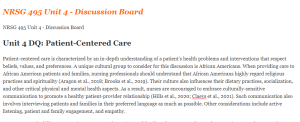NRSG 495 Unit 4 – Discussion Board
NRSG 495 Unit 4 – Discussion Board
Unit 4 DQ: Patient-Centered Care
Patient-centered care is characterized by an in-depth understanding of a patient’s health problems and interventions that respect beliefs, values, and preferences. A unique cultural group to consider for this discussion is African Americans. When providing care to African American patients and families, nursing professionals should understand that African Americans highly regard religious practices and spirituality (Aragon et al., 2018; Brooks et al., 2019). Their culture also influences their dietary practices, socialization, and other critical physical and mental health aspects. As a result, nurses are encouraged to embrace culturally-sensitive communication to promote a healthy patient-provider relationship (Hills et al., 2020; Claeys et al., 2021). Such communication also involves interviewing patients and families in their preferred language as much as possible. Other considerations include active listening, patient and family engagement, and empathy.
Nurses can apply different strategies to promote the patient and family to be a source of control. Promoting control ensures that

patients can take the appropriate health initiatives, including medication adherence, and that the family can monitor and assist the patient where necessary. Wiig et al. (2020) recommended using individual proactive methods whose primary purpose is to involve individuals with the aim of collaboration. When collaborating to enhance health outcomes, these individuals use health information to guide and assist patients and ensure adherence to the treatment plan. As a result, intensive patient education is vital to maximize control.
Concerning interventions, the electronic medical record should document all the essential information that can guide nurses to optimize health outcomes. Appropriate information in the nursing care plan includes current symptoms, medication types and administration, assistance required, and risk factors. This information can be adjusted depending on the patient’s condition, health knowledge, and difficulties experienced during the assessment process. Any other information that can help nursing professionals to monitor vitals and the recovery progress should also be documented.
Click here to ORDER an A++ paper from our Verified MASTERS and DOCTORATE WRITERS: NRSG 495 Unit 4 – Discussion Board
NRSG 495 Unit 4 – Discussion Board References
Aragon, S. J., Sherrod, D. R., Mcguinn, L. J., & Gesell, S. B. (2018). Nursing patient-centeredness improves African-American female medicare patients’ experience-of-care. Journal of Best Practices in Health Professions Diversity: Research, Education and Policy, 11(2), 123–134. https://www.ncbi.nlm.nih.gov/pmc/articles/PMC8929674/
Brooks, L. A., Manias, E., & Bloomer, M. J. (2019). Culturally sensitive communication in healthcare: a concept analysis. Collegian, 26(3), 383-391. https://doi.org/10.1016/j.colegn.2018.09.007
Claeys, A., Berdai-Chaouni, S., Tricas-Sauras, S., & De Donder, L. (2021). Culturally sensitive care: Definitions, perceptions, and practices of health care professionals. Journal of Transcultural Nursing, 32(5), 484-492. https://doi.org/10.1177/1043659620970625
Hills, O., & Shah, D. (2020). Online health information seeking, medical care beliefs and timeliness of medical check-ups among African Americans. Patient Education and Counseling, 103(12), 2468-2476. https://doi.org/10.1016/j.pec.2020.06.006
Wiig, S., Rutz, S., Boyd, A., Churruca, K., Kleefstra, S., Haraldseid-Driftland, C., … & van de Bovenkamp, H. (2020). What methods are used to promote patient and family involvement in healthcare regulation? a multiple case study across four countries. BMC Health Services Research, 20(1), 1-15. https://doi.org/10.1186/s12913-020-05471-4
Primary Task Response: Within the Discussion Board area, write 300–500 words that respond to the following questions with your thoughts, ideas, and comments. This will be the foundation for future discussions by your classmates. You are required to use 2 scholarly resources, in addition to your textbook. Be substantive and clear, and use examples to reinforce your ideas.
Patient-centered care takes into consideration patient preferences, values, and needs. Discuss the following:
- Select a cultural or religious group to consider for this discussion. Choose one that you may interact with frequently in your clinical setting.
- Using your experience or research, what preferences, values, and needs would you anticipate that the patient and family members may need?
- In what ways can you promote the patient and family members to be a source of control?
- What interventions will you document in the electronic medical record in the nursing care plan based on your assessment of the patient’s preferences, values, and needs?
Responses to Other Students: Respond to at least 2 of your fellow classmates with at least a 150-word reply about their Primary Task Response regarding items you found to be compelling and enlightening. To help you with your discussion, please consider the following questions:
- What did you learn from your classmate’s posting?
- What additional questions do you have after reading the posting?
- What clarification do you need regarding the posting?
- What differences or similarities do you see between your posting and other classmates’ postings?
For assistance with your assignment, please use your textbook and all course resources.
NRSG 495 Unit 4 – Discussion Board Rubric
The Discussion Board Grading Rubric is a scoring tool that represents the performance expectations for the discussion. This Discussion Board Grading Rubric is divided into components that provide a clear description of what should be included within each component of the discussion. It’s the roadmap that can help lead your discussion. Discussion Board Grading Rubric

